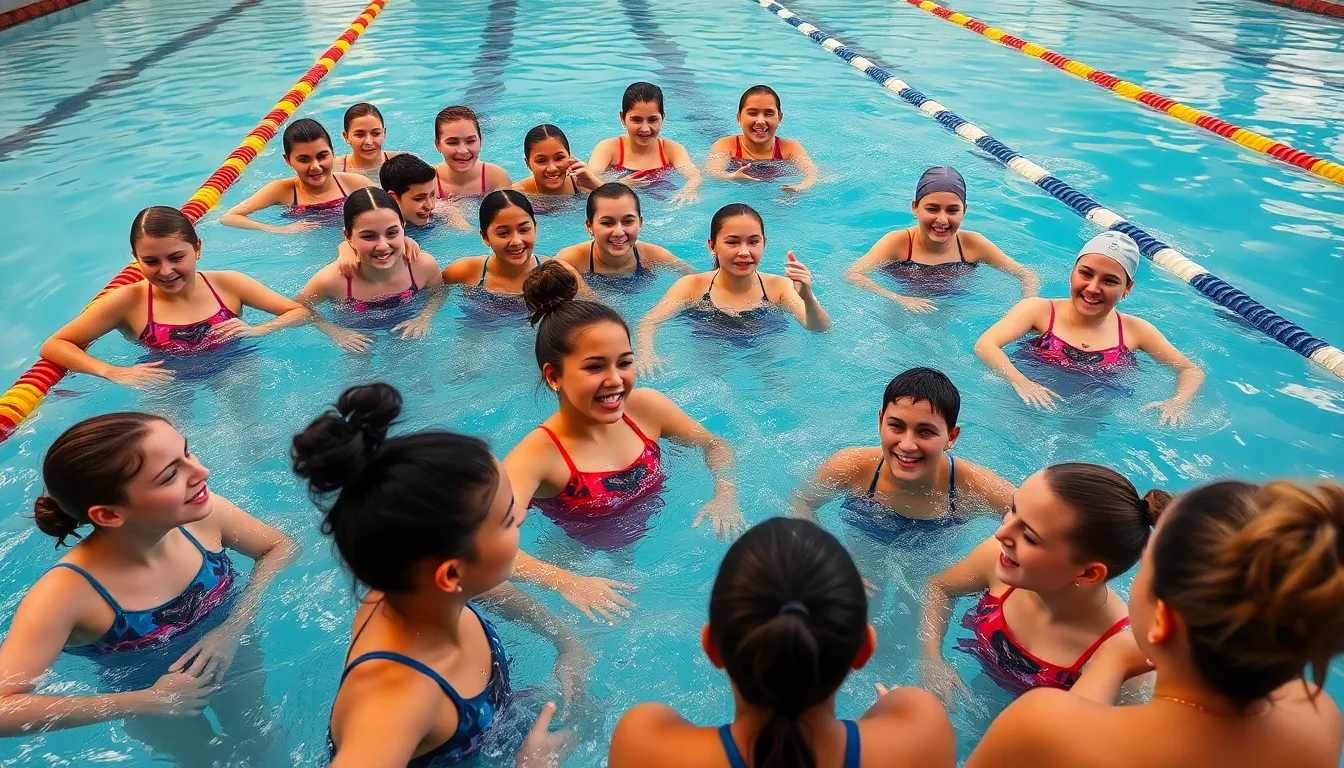Joining the freshman high school swim team isn’t just about mastering the art of diving into a pool; it’s a rite of passage. Picture this: a bunch of wide-eyed freshmen, flailing like jellyfish at first, but soon transforming into sleek swimmers who glide through water like dolphins. It’s not just about the strokes; it’s about the friendships, the laughs, and maybe a few epic belly flops that’ll be talked about for years.
Swimming isn’t just a sport; it’s a splashy adventure filled with early morning practices and the thrill of competition. From learning to navigate the lanes to perfecting that elusive flip turn, the swim team offers a unique blend of teamwork and personal growth. So, whether you’re looking to make waves or just want to avoid the dreaded high school cafeteria food, the freshman swim team might just be the perfect plunge into high school life.
Table of Contents
ToggleOverview Of The Freshman High School Swim Team
Freshman high school swim teams serve as a crucial entry point for students eager to dive into competitive swimming. These teams typically include students in their first year of high school, allowing them to develop swimming skills and experience camaraderie.
Team members often practice several times a week, focusing on stroke techniques, endurance, and speed. Regular practices help foster a sense of discipline, while swimmers learn to manage time effectively between academics and athletics.
Participation in swim meets provides opportunities for personal achievement and team recognition. Freshmen regularly compete in various events, showcasing skills in freestyle, backstroke, breaststroke, and butterfly.
Friendships form quickly among teammates, contributing to a supportive environment. They encourage one another during practice and competitions, creating lasting memories.
Coaches play a pivotal role in shaping the team’s culture and guiding individual athletes. Their expertise helps students refine techniques and develop strategies for improvement.
Personal growth stands out as a significant benefit of joining the swim team. Freshmen often experience increased confidence, improved physical fitness, and enhanced social skills.
Ultimately, the freshman swim team becomes more than just a sport; it’s a platform for personal development. Students navigate challenges while enjoying the thrill of competition and forming friendships that can last throughout high school.
Benefits Of Joining The Swim Team

Joining the swim team offers numerous advantages that extend beyond the pool. Participation fosters both physical health and social connections.
Physical Health Benefits
Swimming provides an excellent full-body workout. Students enhance their cardiovascular endurance while engaging various muscle groups. Regular practice leads to improved flexibility and strength, benefiting overall fitness levels. The low-impact nature of swimming minimizes risks of injury, making it suitable for all athletic abilities. Engaging in swim meets develops stamina, helping athletes manage stress better. By being part of the swim team, freshmen gain a routine that promotes healthy habits for life.
Social Interaction And Team Building
Strong bonds form among teammates, creating lasting friendships. Support from peers fosters a sense of belonging, enhancing the high school experience. Freshmen learn essential collaboration skills through shared training and competing together. Encouragement from teammates inspires individuals to push their limits and achieve personal bests. Coaches facilitate teamwork by promoting communication and trust among swimmers. Engaging in social events builds camaraderie, establishing a supportive network. Ultimately, the swim team serves as an environment where connections thrive and memories are made.
Preparing For Tryouts
Preparing for tryouts demands focus and dedication. Freshmen should prioritize understanding their abilities and how to present them effectively.
Essential Skills To Showcase
Demonstrating relevant skills impresses coaches. Competitive swimmers need proficiency in basic strokes such as freestyle, backstroke, breaststroke, and butterfly. Maintaining proper breathing techniques has significance in all strokes. Showcasing endurance through consistent sprinting reveals one’s stamina. In addition, demonstrating diving skills during entry into the water enhances the swimmer’s overall impression. Lastly, exhibiting strong turns at the walls can set swimmers apart, revealing their technical prowess.
Tips For Success During Tryouts
Success during tryouts hinges on various strategies. Arriving early shows commitment and allows time to warm up. Remaining well-hydrated boosts performance. Athletes need to listen attentively to the coach’s instructions for clarity. Staying positive and supportive of fellow teammates fosters an encouraging atmosphere. Wearing appropriate swim gear for comfort can enhance performance. Additionally, showcasing a willingness to learn and adapt makes an impressive impact. Finally, maintaining focus during scrutinized moments showcases determination and passion for the sport.
Training And Practice Schedule
Training for a freshman high school swim team involves a dedicated schedule that maximizes skill development and teamwork. Practices typically occur five days a week, with sessions lasting 1.5 to 2 hours each. Early morning workouts often start around 6 AM, encouraging athletes to build discipline and time management skills.
Warm-up routines begin every session with swimming laps at a relaxed pace. Following warm-ups, specific drills focus on improving stroke techniques for all four competitive strokes: freestyle, backstroke, breaststroke, and butterfly. Endurance training incorporates interval sets, aiming to enhance stamina and speed.
Swimmers also participate in dryland training once or twice a week. These sessions include strength exercises, flexibility routines, and core workouts. Developing muscle strength, perfecting technique, and ensuring flexibility are critical for achieving peak performance.
Mock meets hold significant importance in the training schedule. These practice competitions simulate the pressure of actual events, allowing athletes to refine their strategies. In addition, coaches often provide timed trials, helping swimmers track their progress and set personal goals.
Throughout the season, swimmers compete in various events, from sprints to longer distances. Each meet serves as an opportunity to earn personal best times and contribute to team scores. Coaches analyze performance during meets, offering constructive feedback for improvement.
Social gatherings, such as team dinners and bonding activities, complement the rigorous practice schedule. Building relationships among teammates enhances camaraderie and support throughout the season. This blend of training, competition, and social engagement fosters not only athletic growth but also strong friendships that last beyond the pool.
Balancing Academics And Swimming
Freshmen on the swim team face the challenge of balancing their academic responsibilities with their commitment to swimming. Time management becomes crucial as the swim season progresses. Effective planning involves prioritizing assignments, studying for exams, and attending practices.
Coaches often emphasize homework schedules, helping students integrate their academic and sports lives. Regular communication with teachers can facilitate understanding and accommodate training demands. It’s beneficial for freshmen to establish a routine that allocates time for both schoolwork and training.
Participation in swimming may actually enhance academic performance, as physical activity is linked to improved concentration and mental alertness. Engaging in a rigorous practice schedule teaches discipline and reinforces work ethic. Freshmen often report feeling more focused and motivated in their studies.
Teammates support each other in maintaining this balance. Group study sessions become helpful, allowing students to combine academic work with social interactions. Shared goals within the swim team cultivate a strong network, leading to productive partnerships in both academics and athletics.
Utilizing weekends or light practice days can provide time for catch-up. Focusing on long-term academic objectives alongside swim goals helps maintain motivation throughout the season. Creating an organized study space minimizes distractions and aids concentration.
Ultimately, a successful freshman swim team experience incorporates both academic excellence and athletic growth. Through dedication, teamwork, and structured planning, students thrive in a demanding yet rewarding environment.
Joining a freshman high school swim team is an enriching experience that shapes students both in and out of the pool. The journey from novice to skilled swimmer is filled with challenges and triumphs that foster personal growth. Friendships formed during early morning practices and competitive events create a supportive environment that encourages teamwork and camaraderie.
As students navigate the demands of academics and athletics, they develop essential life skills like discipline and time management. The guidance of coaches and the encouragement from teammates help build confidence and resilience. Ultimately, the freshman swim team serves as a foundation for lifelong friendships and a deeper appreciation for the sport, making it a memorable chapter in their high school journey.





